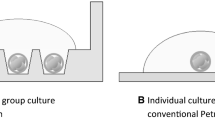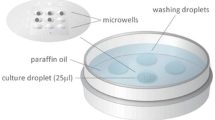Abstract
Purpose
A microwell culture system that facilitates group culture, such as well-of-the-well (WOW), improves embryonic development in an individual culture. We examined the effect of WOW on embryonic development in vitro with commercially available human single culture media.
Methods
Using four different commercial human single culture media, in vitro development and imprinted gene expression of bovine embryos cultured in WOW were compared to droplet culture (one zygote per drop). To determine the effects of microwell and group culture on embryonic development, different numbers of embryos were cultured in droplet or WOW. Diffusion simulation of accumulating metabolites was conducted using the finite volume method.
Results
WOW had a positive effect on bovine embryonic development, regardless of the type of single culture media. Imprinted gene expression was not different between droplet- and WOW-derived blastocysts. The microwell and group cultures in WOW showed a significant positive effect on the rate of total blastocysts and the rate of development to the expanded and hatching blastocyst stages. The assumed cumulative metabolite concentration of WOW with one embryo was 1.47 times higher than that of droplet culture with one embryo. Furthermore, the concentration of WOW with three embryos was 1.54 times higher than that of WOW with one embryo.
Conclusions
In using human single culture media, a microwell culture system that allows group culture could be a powerful clinical tool for improving the success of assisted reproductive technologies.





Similar content being viewed by others
References
Manipalviratn S, DeCherney A, Segars J. Imprinting disorders and assisted reproductive technology. Fertil Steril. 2009;91:305–15.
Rebar RW. What are the risks of the assisted reproductive technologies (ART) and how can they be minimized? Reprod Med Biol. 2013;12:151–8.
Summers MC, Biggers JD. Chemically defined media and the culture of mammalian preimplantation embryos: historical perspective and current issues. Hum Reprod Update. 2003;9:557–82.
Gardner DK, Lane M. Culture of viable human blastocysts in defined sequential serum-free media. Hum Reprod. 1998;13(Suppl 3):148–59. discussion 160
Biggers JD, Summers MC. Choosing a culture medium: making informed choices. Fertil Steril. 2008;90:473–83.
Gardner DK, Lane M. Culture and selection of viable blastocysts: a feasible proposition for human IVF? Hum Reprod Update. 1997;3:367–82.
Lane M, Gardner DK. Increase in postimplantation development of cultured mouse embryos by amino acids and induction of fetal retardation and exencephaly by ammonium ions. J Reprod Fertil. 1994;102:305–12.
Calhaz-Jorge C, De Geyter C, Kupka MS, de Mouzon J, Erb K, Mocanu E, et al. Assisted reproductive technology in Europe, 2013: results generated from European registers by ESHRE. Hum Reprod. 2017;32:1957–73.
Petersen BM, Boel M, Montag M, Gardner DK. Development of a generally applicable morphokinetic algorithm capable of predicting the implantation potential of embryos transferred on day 3. Hum Reprod. 2016;31:2231–44.
Gardner DK, Meseguer M, Rubio C, Treff NR. Diagnosis of human preimplantation embryo viability. Hum Reprod Update. 2015;21:727–47.
Smith GD, Takayama S, Swain JE. Rethinking in vitro embryo culture: new developments in culture platforms and potential to improve assisted reproductive technologies. Biol Reprod. 2012;86:62.
O'Doherty EM, Wade MG, Hill JL, Boland MP. Effects of culturing bovine oocytes either singly or in groups on development to blastocysts. Theriogenology. 1997;48:161–9.
Larson MA, Kubisch HM. The effects of group size on development and interferon-tau secretion by in-vitro fertilized and cultured bovine blastocysts. Hum Reprod. 1999;14:2075–9.
Khurana NK, Niemann H. Effects of oocyte quality, oxygen tension, embryo density, cumulus cells and energy substrates on cleavage and morula/blastocyst formation of bovine embryos. Theriogenology. 2000;54:741–56.
Gardner DK, Lane M. Amino acids and ammonium regulate mouse embryo development in culture. Biol Reprod. 1993;48:377–85.
Johnson MH, Nasr-Esfahani MH. Radical solutions and cultural problems: could free oxygen radicals be responsible for the impaired development of preimplantation mammalian embryos in vitro? Bioessays. 1994;16:31–8.
Fukui Y, Lee ES, Araki N. Effect of medium renewal during culture in two different culture systems on development to blastocysts from in vitro produced early bovine embryos. J Anim Sci. 1996;74:2752–8.
Vajta G, Peura TT, Holm P, Paldi A, Greve T, Trounson AO, et al. New method for culture of zona-included or zona-free embryos: the well of the well (WOW) system. Mol Reprod Dev. 2000;55:256–64.
Hoelker M, Rings F, Lund Q, Phatsara C, Schellander K, Tesfaye D. Effect of embryo density on in vitro developmental characteristics of bovine preimplantative embryos with respect to micro and macroenvironments. Reprod Domest Anim. 2010;45:e138–45.
Hoelker M, Rings F, Lund Q, Ghanem N, Phatsara C, Griese J, et al. Effect of the microenvironment and embryo density on developmental characteristics and gene expression profile of bovine preimplantative embryos cultured in vitro. Reproduction. 2009;137:415–25.
Sugimura S, Akai T, Somfai T, Hirayama M, Aikawa Y, Ohtake M, et al. Time-lapse cinematography-compatible polystyrene-based microwell culture system: a novel tool for tracking the development of individual bovine embryos. Biol Reprod. 2010;83:970–8.
Sugimura S, Akai T, Imai K. Selection of viable in vitro-fertilized bovine embryos using time-lapse monitoring in microwell culture dishes. J Reprod Dev. 2017;63:353–7.
Menezo YJ, Herubel F. Mouse and bovine models for human IVF. Reprod BioMed Online. 2002;4:170–5.
Sugimura S, Akai T, Hashiyada Y, Somfai T, Inaba Y, Hirayama M, et al. Promising system for selecting healthy in vitro-fertilized embryos in cattle. PLoS One. 2012;7:e36627.
Brackett BG, Oliphant G. Capacitation of rabbit spermatozoa in vitro. Biol Reprod. 1975;12:260–74.
Stringfellow DA, Givens SM. Manual of the International Embryo Transfer Society, 4th ed. International Embryo Transfer 2010.
Hashiyada Y, Okada M, Imai K. Transition of the pregnancy rate of bisected bovine embryos after co-transfer with trophoblastic vesicles prepared from in vivo-cultured in vitro-fertilized embryos. J Reprod Dev. 2005;51:749–56.
Matsuura K. Numerical calculations for diffusion effects in the well-of-the-well culture system for mammalian embryos. Reprod Fertil Dev. 2014;26:742–51.
Swain JE, Smith GD. Advances in embryo culture platforms: novel approaches to improve preimplantation embryo development through modifications of the microenvironment. Hum Reprod Update. 2011;17:541–57.
Dominguez F, Gadea B, Esteban FJ, Horcajadas JA, Pellicer A, Simon C. Comparative protein-profile analysis of implanted versus non-implanted human blastocysts. Hum Reprod. 2008;23:1993–2000.
Lane M, Gardner DK. Ammonium induces aberrant blastocyst differentiation, metabolism, pH regulation, gene expression and subsequently alters fetal development in the mouse. Biol Reprod. 2003;69:1109–17.
Gardner DK, Hamilton R, McCallie B, Schoolcraft WB, Katz-Jaffe MG. Human and mouse embryonic development, metabolism and gene expression are altered by an ammonium gradient in vitro. Reproduction. 2013;146:49–61.
Virant-Klun I, Tomazevic T, Vrtacnik-Bokal E, Vogler A, Krsnik M, Meden-Vrtovec H. Increased ammonium in culture medium reduces the development of human embryos to the blastocyst stage. Fertil Steril. 2006;85:526–8.
Kleijkers SH, van Montfoort AP, Bekers O, Coonen E, Derhaag JG, Evers JL, et al. Ammonium accumulation in commercially available embryo culture media and protein supplements during storage at 2–8 degrees C and during incubation at 37 degrees C. Hum Reprod. 2016;31:1192–9.
Vajta G, Korosi T, Du Y, Nakata K, Ieda S, Kuwayama M, et al. The well-of-the-well system: an efficient approach to improve embryo development. Reprod BioMed Online. 2008;17:73–81.
Sugimura S, Akai T, Hashiyada Y, Aikawa Y, Ohtake M, Matsuda H, et al. Effect of embryo density on in vitro development and gene expression in bovine in vitro-fertilized embryos cultured in a microwell system. J Reprod Dev. 2013;59:115–22.
Kang SS, Ofuji S, Imai K, Huang W, Koyama K, Yanagawa Y, et al. The efficacy of the well of the well (WOW) culture system on development of bovine embryos in a small group and the effect of number of adjacent embryos on their development. Zygote. 2015;23:412–5.
Wydooghe E, Vandaele L, Piepers S, Dewulf J, Van den Abbeel E, De Sutter P, et al. Individual commitment to a group effect: strengths and weaknesses of bovine embryo group culture. Reproduction. 2014;148:519–29.
Gopichandran N, Leese HJ. The effect of paracrine/autocrine interactions on the in vitro culture of bovine preimplantation embryos. Reproduction. 2006;131:269–77.
Roudebush WE, Wininger JD, Jones AE, Wright G, Toledo AA, Kort HI, et al. Embryonic platelet-activating factor: an indicator of embryo viability. Hum Reprod. 2002;17:1306–10.
Acknowledgements
We thank Editage (https://www.editage.jp/) for editing the draft of this manuscript.
Author information
Authors and Affiliations
Corresponding authors
Ethics declarations
This study has been approved by Minotomirai Yume Clinic ethics committee.
Electronic supplementary material
Supplementary Movie S1
Diffusion kinetics of metabolites from embryos cultured in droplet and LinKIDⓇ micro8 (LinKID). Cumulative metabolites in droplet with one embryo (left) and LinKID with three embryos (right) which color indicates the metabolites concentration. Minimum concentration, zero mol is colored with blue and maximum value, 3.0E−09 mol is colored with red on the right color scale (AVI 554 kb)
ESM 1
(DOCX 17 kb)
Rights and permissions
About this article
Cite this article
Ieda, S., Akai, T., Sakaguchi, Y. et al. A microwell culture system that allows group culture and is compatible with human single media. J Assist Reprod Genet 35, 1869–1880 (2018). https://doi.org/10.1007/s10815-018-1252-z
Received:
Accepted:
Published:
Issue Date:
DOI: https://doi.org/10.1007/s10815-018-1252-z




